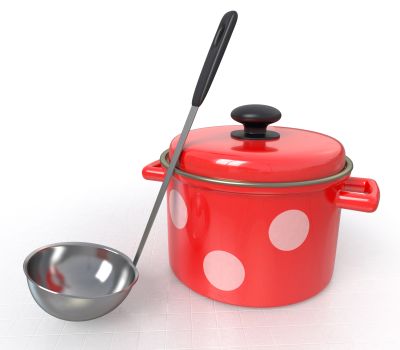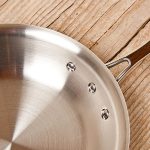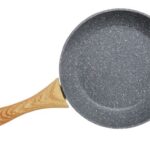Enameled steel cookware has become popular due to the ideal combination of beauty and functionality. This cookware is constructed with carbon steel or stainless-steel core and coated with enamel. During the manufacturing process, a thin layer of glass is applied to the metal under high heat to protect it from rust.
Enamel on steel is often used in the production of cookware items, such as stockpots, canners, saucepans, skillets, double boilers, Dutch ovens, steamers, roasters, grease keepers, and teakettles. This cookware is preferably used for water-based cooking, but there are some exceptions such as enameled carbon steel pan for cooking Spanish paella. Enameled steel cookware is also popular among campers, because it is lightweight, heats up fast, and cleanup is a breeze.
This type of cookware is much lighter than enameled cast iron. Steel core also heats and cools much faster than cast iron, so you may need to make some adjustments in cooking time if you have been cooking preferably in the cast iron cookware.

Advantages of Enamel Over Steel Cookware
- Enamel over steel cookware is versatile enough to function efficiently on a full range of heat sources. The steel core makes it suitable for use on induction cooktops.
- Enamel on steel construction offers fast heating and even heat distribution. The carbon steel base is more heat-responsive and heats more evenly than a stainless steel base. In both cases, the most cooking task can be accomplished using low to medium heat which makes this type of cookware energy efficient.
- Enamel coating prevents chemicals from the metal core from leaching into your meals and reacting with acidic ingredients in foods. It also doesn’t hold flavors or alter the taste of your food. As long as the coating remains in good condition, the cooking surface is completely safe for cooking, marinating, and serving foods.
- Enamel over steel cookware can be very visually appealing. A beautifully painted exterior will brighten up any kitchen. This cookware can go from the stove straight to the table, saving you time, and making your table more eye appealing.
- Enamel coating does not require any seasoning to maintain it. The enamel surface is smooth and very easy to clean and care for. Enameled cookware won’t rust as long as the coating remains undamaged.
How to Use Enameled Steel Cookware Properly
Always read the manufacturer’s instructions to make sure you use your cookware properly.
To protect the beauty and functionality of your enameled steel cookware, avoid using it over high heat. Too high heat can destroy enamel coating. Use low to medium heat settings to get the best cooking results and to keep your cookware in good condition.
Choose the stovetop heat zone that matches the pot’s base to maximize efficiency, prevent damage to the handles, and make cleaning easier. For the same reason, make sure the flame doesn’t go up the sides of the pot when you are cooking on a gas stove.
Most enamel on steel cookware products is oven-safe up to 360° F – 500°F. Keep in mind that the handles of the lid may be less heat tolerant than the bottom and sides of your pot. You need to read the user manual carefully to find out how to use your cookware in the oven.
Never leave your pot dry and empty on the hot stove. Don’t let liquids boil dry, as this will damage the coating.
Although enamel-on-steel cookware is stick-resistant, occasional food sticking may occur, especially if you are using high heat. Another cause of sticking is food films, so make sure to clean the cookware thoroughly. Coating the cooking surface with a small amount of cooking oil or non-stick cooking spray helps to prevent sticking.
Enamel-on-steel pots are great for cooking and serving soups, stews, spiced wine, spiced cider, steaming, and boiling pasta rice and beans, and so on.
After you finish cooking, place the pot on a wooden cutting board, or a trivet mat. Wear kitchen gloves when picking it up, as non-insulated handles get very hot to the touch and can burn your hands.
Use only silicone, wooden, or plastic utensils because metal utensils may scratch the enamel finish.
Finally, don’t drop the cookware or bang it onto a hard object as it can get dents and email may chip. If the email is chipped inside the cookware it is no longer safe to use for cooking purposes.
Cleaning
Some manufacturers claim that their enamelware is dishwasher safe. However, to preserve the glossy finish, hand washing is recommended. Harsh dishwasher detergents may deteriorate the shine, while vibration and friction with sharp items can damage the enamel coating.
Before using your brand-new enameled cookware, use a non-metal utensil and alcohol to remove the label stickers. Then wash the pot with mild dishwashing detergent and warm water, Rinse and dry with a cloth.
Enameled steel cookware has a nonporous glass-like surface, which makes cleaning a snap. Allow your cookware to cool before washing to prevent warping and ensure its longevity. For regular cleaning, simply hand-wash with warm water and mild soap and use a non-abrasive sponge. Steel wool and abrasive cleaners are not recommended as they would scratch the enamel surface. Do not submerge the item in water for a prolonged time as the moisture trapped inside may result in rusting. Dry with a cloth or paper towel before storing.
If food sticks to it, fill the cookware item with warm water, leave it for an hour and the residue will come off.
Burnt-on foods can be removed by filling the pot with hot, soapy water, or by a mixture of water and baking soda. Place the pot over low heat for 15 to 20 minutes. Allow it to cool, then wash and rinse as normal.
Mineral deposits from hard water may appear at the waterline. To remove those built-up minerals, use vinegar or baking soda.
Some food may leave stains on the enamel surface. Sprinkle some baking soda on the wet surface of your pot and rub it with a sponge to bring the original color back.
Store your cookware carefully. Avoid overcrowding that can damage the enamel surface.
Popular Brands of Enamel on steel Cookware include Le Creuset, Paula Deen, Rachael Ray, Cuisinart, Chantal, Granite Ware, The Pioneer Woman, Red Co, Reston Lloyd, Farberware, and Metalac.




so what to buy corbon steel or enamel steel
I would like to re-enamel my steel pots because the old enamel is damaged and removed. Paint shops are unable to supply with non toxic paint. Please help. I still love my pots but now they are unsafe to use.